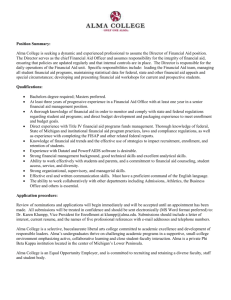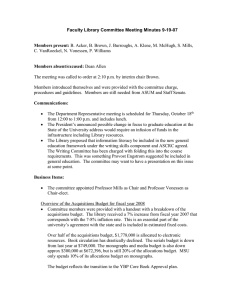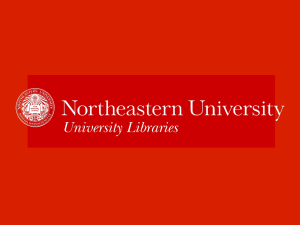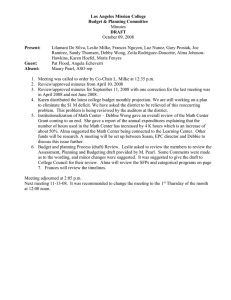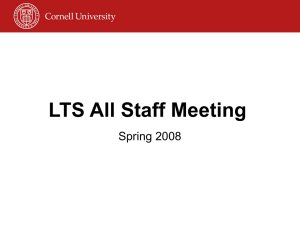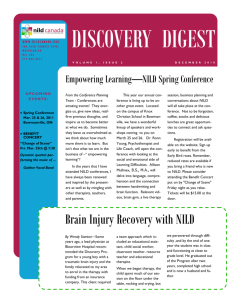The New Face of Technical Services: Opportunities and Challenges
advertisement
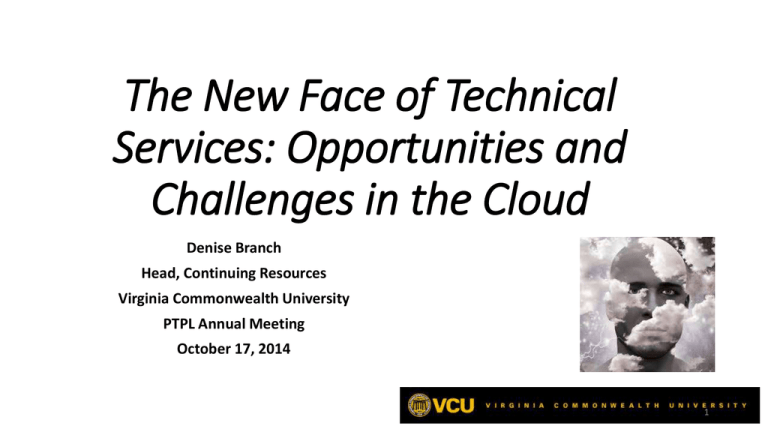
The New Face of Technical Services: Opportunities and Challenges in the Cloud Denise Branch Head, Continuing Resources Virginia Commonwealth University PTPL Annual Meeting October 17, 2014 1 A Little VCU History • One of Virginia’s largest research institutions located in Richmond, VA • 2 campuses – Monroe Park & Medical College of Virginia • 223 degrees and certificate programs within 13 schools and one college • VCU Health System supports the university’s health care education, research and patient care mission • Enrolls over 31,000 students • Operates programs in Qatar and Northern Virginia • Home of the VCU Rams 2 • • • • • • • • • • • Holdings exceeding 2.5 million volumes 61,000 serials 600,000 e-books 51 professionals and 90 support staff Centralized processing of materials Annual budget exceeds $17.5 million URL Link Resolver SFX 2004-2012 Aleph 1994-2012, Alma 2012 Primo Discovery Tool 2011 Virtual Library of Virginia (VIVA) Consortium New addition to library – expected to open in Fall 2015 Getting acquainted with VCU Libraries 3 Construction of the new addition to the library has begun… • Mid-May brought major visible changes to Cabell Library, a foretaste of the construction work ahead. The atrium, part of the original 1970s building, came down; construction fencing went up; new hardscapes were laid; and the retaining wall of the loading dock beside the building was removed. 4 • Technical services division previously called Cataloging, Technical Services and Information Systems (CTSIS) until 2013 • Made up of 5 departments: Acquisitions, Cataloging, Collection Management, Preservation, Library Information Systems • In 2013 VCU Libraries launched a reorganization of technical services division • Renamed Information Management & Processing (IMP) in April 2013 • Current structure consists of 4 departments: Metadata & Discovery, Collection Analysis and Investment, Digital Technologies, Preservation and Inventory Management Technical Services model past and present… 5 • • • • • • • • • • • • Traditional technical services Ever increasing acquisition of e-resources since 2004 Ex Libris Open URL link Resolver SFX - implemented 2004 Developed e-reports to address user access problems & staff internal problems in 2004 Ex Libris Discovery tool Primo - implemented 2011 Cloud based library uniform management system, Ex Libris’ Alma in 2012 Head of Acquisitions Department retired - April 2013 Existing organizational model breaking down After study, collaborative work and planning, a new model was put in place in 2013 Reorganized to focus on new technologies and eresources Blending of formerly separate departments Developing workflows to enhance discovery and access This is our story… 6 Traditional Acquisitions Department duties up until April 2004… • Made up of 3 units (Order, Firm Order & Accounting, Serials) Order – ordered all materials Firm Order & Accounting – processed invoices, received monographs Serials – maintained all serials • License negotiation - performed by Head of Acquisitions • Serials management – Asst Head Acquisitions • Links to the small number of e-resources were put in the OPAC for user access and maintained there • No link resolver until 2004 7 • Before 2004, print centric workflows • Increase in acquisition of e-resources began in 2004 • There had to be a better way to manage eresources • SFX was implemented in 2004 to help manage eresources and provide access to users • Assistant Head of Acquisitions / Serials librarian responsible for administrative management of SFX • Serials Unit became responsible for troubleshooting access problems and answering user problem reports (Serials Librarian & 1 staff member dedicated to e-serials) • License negotiation was shared between the Head of Acquisitions and Assistant Head of Acquisitions & Serials librarian • Focus: ordering e-resources, license negotiation and maintenance of titles in SFX Revisioning of Acquisitions Department began in 2004… 8 2005 - Serials staff responsibilities after major acquisition of eresources and before Alma… Core Responsibilities Time Spent Maintains records for full-text e-journals and e-serials in SFX and link-out functions from databases to articles 35% Reviews and investigates reports regarding electronic formats 20% Responds to inquiries regarding availability and status of e-resources 30% Maintains department web pages and database of license agreements 15% 9 2007 - Big shift in Serials responsibilities after major influx of e-resources and implementation of SFX Open URL link resolver… • Print subscriptions were being transferred to e-only subscriptions • 3 staff members were dedicated mainly to e-resources with very few print tasks • Remaining 4 staff had a combination of print and eresource tasks • Remaining 4 staff had more electronic tasks folded into responsibilities over the next 7 years 10 2014 - Continuing Resources responsibilities after Alma and reimagining… Core Responsibilities Time Spent Investigates and resolves e-serials problems 35% Investigates Alma weekly Community Zone Updates reports 20% Responds to inquiries regarding availability and status of e-resources 15% Updates Alma as packages are added, renewed, canceled or changed 15% Adds licenses and amendments to Alma 15% 11 • Before influx of e-resources and implementation of Alma, Primo, WorldShare Metadata Collection Manager • Primary discovery interface for e-resources was the OPAC • All titles had to be managed in the OPAC • Title lists and URLs were procured from publishers • One by one titles and links were added to the OPAC and holdings updated in OCLC • Lots of time spent in maintaining the OPAC and OCLC • Traditional cataloging couldn’t keep pace with growing eresources • Focus: finding appropriate bib records, adding and updating links in OPAC, updating OCLC • After influx of e-resources and implementation of Alma, Primo, WorldShare Metadata Collection Manager • Primary discovery interface is Primo • All titles managed in Alma • Titles and collections in Alma Community Zone for activation • Holdings updated via WorldShare Metadata Collection Manager • Loading of MARC records into Alma that create order records • Can perform OCLC search and import records in Alma Metadata Editor without going out of system to OCLC to find records and export • Focus: finding and activating collections in Alma and verifying accurate bib records in Community Zone ensuring discoverability and access Cataloging focus before and after the influx of e-resources… 12 • • • • • • • • • • • • Complicated workflows Disconnects in processes Heavy workloads Disparate systems and information Difficulty tracking e-resources Multiple handoffs Communication silos Lots of paper forms Lots of spreadsheets and files Hardware failures, software installs, upgrades Reducing costs Maintaining a high level of service Heavy workloads Maintaining high service level Disparate systems Complicated Workflows Hardware failures, software installs, upgrades Lots of paper & spreadsheets Disconnects & silos Workflow challenges identified… 13 There has to be a solution! • Looking for ways to streamline electronic workflows and create efficiencies 14 • VCU Libraries researched library management systems • Cloud-based library management system Alma was an attractive prospect • Decision made to become an Early Adopter Alma in 2011 • Implementation began in April 2012 • A great deal of training, testing, meetings, conference calls, webinars, configurations, trials, errors • Go Live! occurred on October 24, 2012 Implementation of Alma… 15 Reimagining Technical Services began… • Head Acquisitions retired April 2013 • Acquisitions Department was split - Acquisitions, Cataloging and Collection Management • Some Acquisitions staff (Serials Unit) went into Cataloging which was renamed Metadata and Discovery • Other Acquisitions staff (Firm Order & Accounting, and Order Unit) went into Collection Management which was renamed Collection Analysis & Inventory • Shifting from stagnant workflows towards more flexible workflows • Focus is moving from acquisitions to discovery and access 16 Why make a change? • New technologies and tools being are being introduced that provide opportunities • Change in leadership created a knowledge gap that needed to be filled • Range of material the library collections is changing • Existing organizational model was not working well • Aspiration to elevate our position among research libraries • Historical workflows that made sense at one time are less compelling • Awareness that library technology and standards need to be continuously updated to keep pace with user needs 17 Focus of the newly created Metadata and Discovery Department (MAD)… • Prepare for construction of new library • Provide access to collections • Prepare new records & maintain the library management system for physical & electronic titles • Manage & monitor vendor supplied shelf-ready books and records • Design metadata access to digital collections • Manage subscriptions to physical and electronic continuing resources • Support access by monitoring & maintaining titles and holdings information • Perform tasks for ongoing management of eresources ensuring access • Troubleshoot user access issues 18 Opportunities in the cloud… • Streamline workflows • Improve delivery of services • Extension of library’s impact • Increase visibility and accessibility of collections • Reduce duplication of work • Automate more processes • Eliminate silos • Focus on innovation • Mobility 19 Opportunities in the cloud continued… • Environment more conducive to collaboration and teamwork • Flexibility • Openness and transparency • Experimenting with new solutions • Taking advantage of technology • Enhancing and developing new skills • Integration with other functions, services and systems • Better able to track progress • Learning new processes 20 Challenges in the cloud… • Learning new technologies • Learning new terminologies driven by technology • Staying abreast of trends • Deepening skills • Roles changing • Continuous training • Lots of data • Wide range of tools • Library service platforms • Staying valuable and relevant for user needs • Troubleshooting access problems 21 Challenges in the cloud continued… • Who is responsible for what? • E-Resources evolving at an accelerated rate • Understanding users information seeking needs • Issues of rights management • Expanded competencies needed for electronic world • Training is constant with increase in new technologies • Workflows need tweaking • Finding workarounds for some processes 22 Metadata and Discovery - Knowledge and skills needed in 2014 – more complex responsibilities… • Provides intellectual access to collections • Prepares new records and maintains the catalog • Designs metadata access • Manages subscriptions to physical and electronic continuing resources and supports access • Performs tasks related to the ongoing management of the library’s electronic resources • Requires high level of computer skills • Ability to learn the Alma system 23 Challenge of identifying users wants, needs and interests… • Embracing new technology • Instant and seamless access • Digital natives & those who aren’t • Ensuring users get the most out of library services • Grasping users that are physically detached from the library 24 Lessons learned… • More pride in work now that I understand more about the e-resource process • Learning the responsibilities of Cataloging buddy has been insightful • Wider variety of roles requires broader range of skills • Awareness of accessibility barriers for users • Alma is always changing • I was fearful of working in the cloud, but I am learning how to maneuver in it and see just how useful it is • Cloud enables me to work from home – all I need is Internet access • Even though we are in the cloud, some processes are still labor intensive • Not able to do a lot when the Internet is down. (Rely so much on the Internet for workflow processes) • Searching in Alma and Primo results in a lot of hits; must really use facets to narrow down results • Had to learn a lot of new terminology that I am still getting used to • Love being able to assign a task to a co-worker in Alma via a task list which can easily be assigned to someone else to complete the workflow process • Love getting rid of paper forms; I was always misplacing forms and having forms pile up • Sometimes you have to keep testing a process over and over until you learn all the steps and finally get it right • Collaborating with co-workers helps to solve a lot of problems faster • Working in Google Docs is a good way to share information with everyone who is working on the same project. We can all be in the Doc at the same time. 25 Future…with construction of the new library addition, comes construction of workflows • Spaces, services, collections and roles evolving • Prepare and motivate staff for changing roles • Concentrate more on collections than individual titles • Collaboration • Demonstrate value to users • Services will be driven to the cloud • Develop an intimate relationship with technology • Support discovery and access • Integration with other systems • Experiment with new solutions to streamline workflows • Still exploring ways to organize 26
